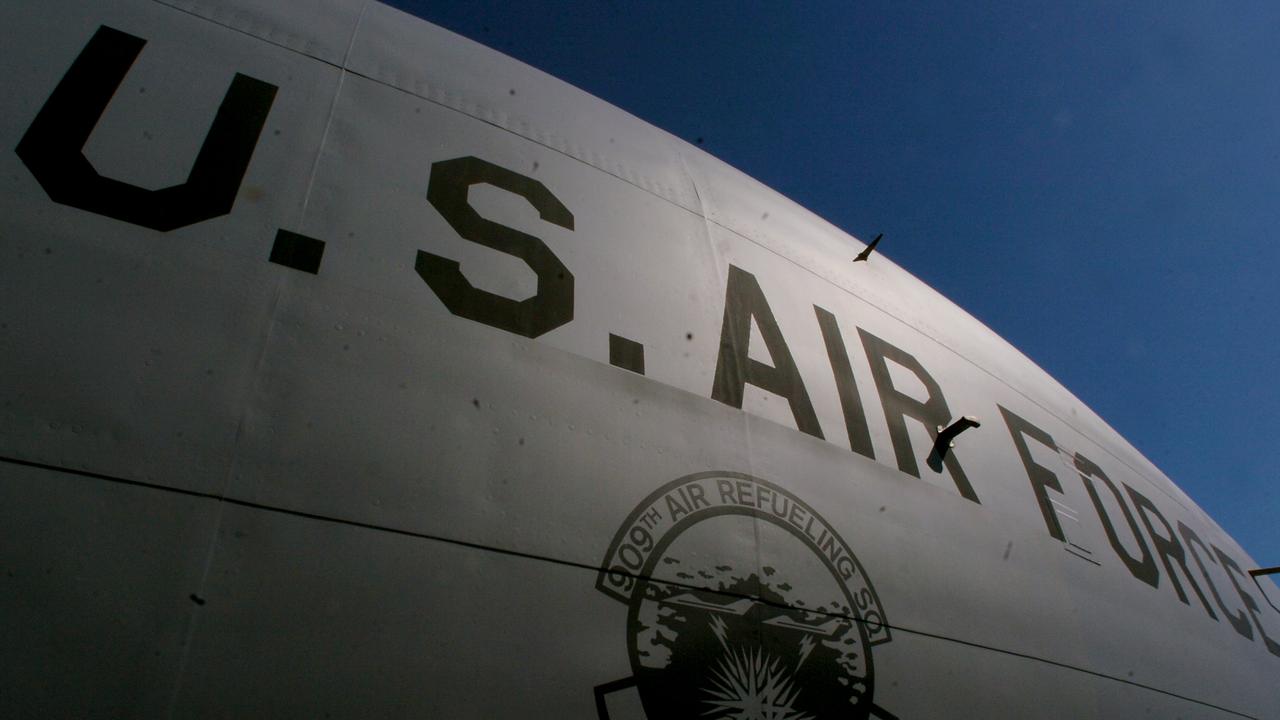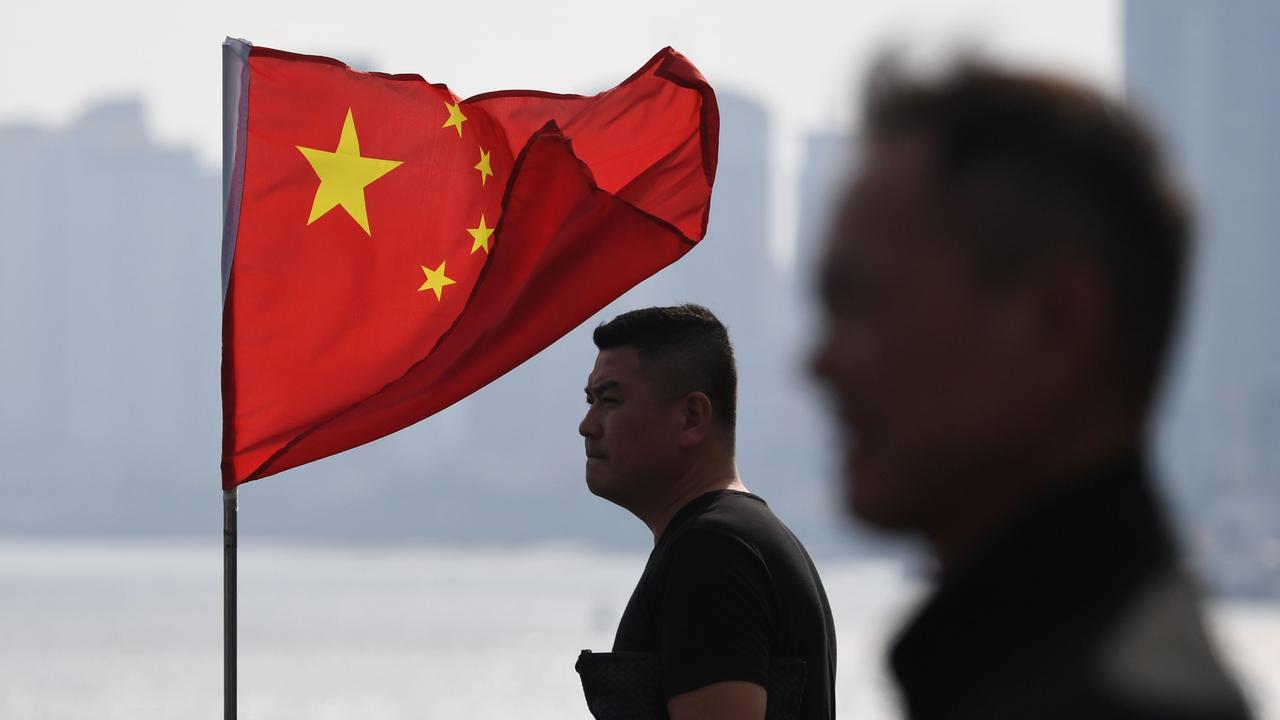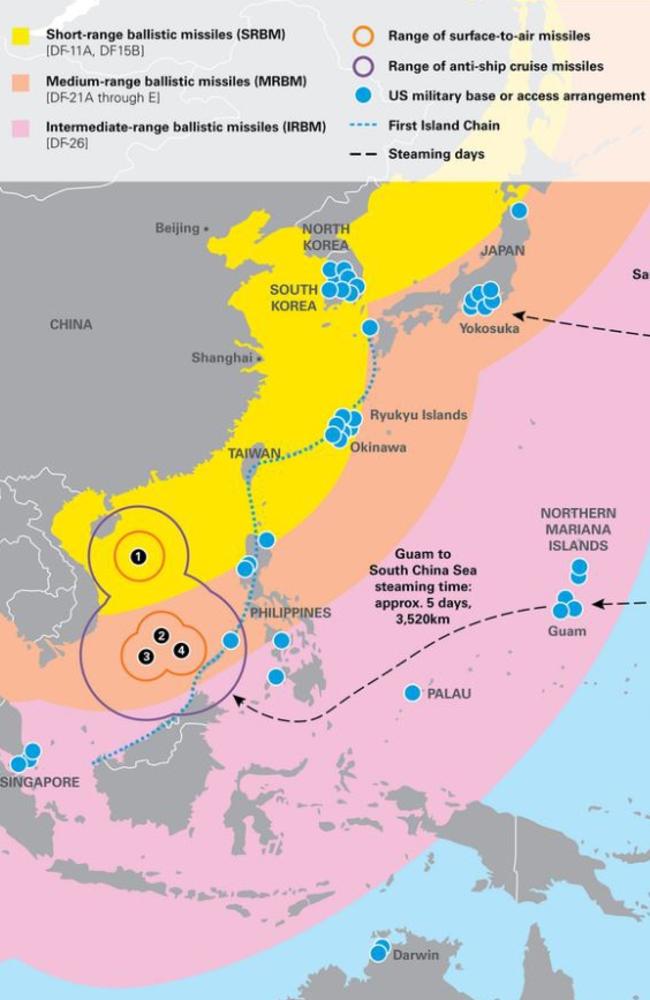US so weakened in Indo-Pacific it could now ‘lose war’ to China
Beijing’s military muscle is so strong, it won’t need months to bring its neighbours and the US to heel. A few well-aimed missiles will do the job.
The US is so weakened in the Indo-Pacific region, it could now lose a short, sharp conflict started by Beijing in just “hours”, up-ending the military order in our region.
Furthermore, Australia is no longer able to rely on Washington to come to its defence.
That’s the conclusion of a blunt new report that found years of spending cuts, an “outdated superpower mindset” and ageing equipment mean US military installations in the region are vulnerable to being wiped out by China in a surprise battle.
“The stakes could not be higher,” the analysis by the University of Sydney’s United States Studies Centre warned.
US and allied ports and airstrips “could be rendered useless by precision strikes in the opening hours of a conflict”, it states.
The US’s woes means Australia will have to step up and make deeper military alliances with countries in the Asia Pacific region — even if that risks enraging Beijing.
Canberra should also focus less on the Middle East and put its resources into the Indo Pacific region, the research advised.
But far from doing that, Prime Scott Morrison today announced Australia would support the US in patrolling the strategic Strait of Hormuz to protect tankers from Iran’s clutches.


“China has undermined America’s ability to project power into the Indo-Pacific, raising the risk that China could use limited force to achieve a fait accompli victory before America can respond,” the US Studies Centre report’s authors said.
“Australia should be deeply concerned about the state of America’s armed forces and strategic predicament in the Indo-Pacific.”
The paper, entitled Averting Crisis: American strategy, military spending and collective defence in the Indo-Pacific, said military balance had been maintained by a line of bases and allies in the region that stretches from Singapore to Japan including Australia and the US island of Guam.
These had created a US aligned bulwark on the so-called First Island Chain, off the coast of China. That had in turn deterred Beijing from, for instance, invading Taiwan, a US ally and democratic nation that China regards as a renegade province.
But Washington’s military pre-eminence was now looking distinctly shaky, the report said.
“The stakes could not be higher. Since the early 1950s, America’s position in the Indo-Pacific has rested on its ability to … preserve a strategic order in which no single nation dominates.
“But this foundation of stability is now under strain. China’s military is increasingly powerful, while America’s war-fighting edge has dangerously eroded.
“Many now warn that the US might fail to deter — or could even lose — a limited war with China, with devastating consequences for the region’s future strategic landscape,” it said.

CHINA COULD WIN BATTLE ‘IN HOURS’
The US military had “atrophied”, the report said, with unpredictable funding leading to ageing machinery, bases that aren’t hardened against attack, strained supply lines and a slow pipeline of new submarines.
Yet between 2006 and 2018, China’s defence spending skyrocketed by 900 per cent.
“China has rapidly transformed its military from an antiquated Soviet-era institution into a sophisticated fighting force that is optimised to challenge American power projection assets,” the report states.
What’s more, Beijing had been studying the US and has concluded that a short conflict knocking out key bases could be all that’s needed.
“This growing arsenal of accurate long-range missiles poses a major threat to almost all American, allied and partner bases, airstrips, ports and military installations in the Western Pacific,” the report states.
“As these facilities could be rendered useless by precision strikes in the opening hours of a conflict, the (Chinese) missile threat challenges America’s ability to freely operate its forces from forward locations throughout the region.
“Beijing could quickly use limited force to achieve a fait accompli victory — particularly around Taiwan, the Japanese archipelago or maritime Southeast Asia — before America can respond, sowing doubt about Washington’s security guarantees in the process.”
The US might win an extended war, but after a shocking first Chinese salvo it might not want to.
“Because America’s interests in the security of its allies are fundamentally secondary to its own survival … Washington may ultimately wager that intervention is not worth the candle.”


AUSTRALIA NEEDS TO PIVOT
This would be of “grave concern” to Australia, the report said, as it would weaken the US’s military guarantees.
An emboldened China might then reign supreme in the international waters off its coast, take Taiwan and other disputed territories and be able to project its military influence far further than at present.
“Although far removed from tensions along the First Island Chain, Australia’s freedom of action and ability to evade military coercion are ultimately linked to the preservation of a stable balance of power and a regional order that is not dominated by China,” the report states.
To prevent that outcome, Australia should pivot from a “security contributor” to a “frontline ally” as the US’s regional power weakened.
“Middle powers with capable militaries — such as Australia and Japan — would work alongside the US and vulnerable regional partners to strengthen deterrence in strategically critical flashpoints like Taiwan, the East China Sea, maritime Southeast Asia and the Pacific,” the report advised.
“Australia should strategically re-prioritise forces and focus operational resources on the Indo-Pacific. At present, a significant portion of the Australian Defence Force (ADF) and its own finite resources remain entangled in ongoing operations in the Middle East.”
Earlier today, Prime Minister Scott Morrison announced he would devote Australian resources to a military campaign in the Strait of Hormuz, at the US’s request.
Another report, also released this week, by think tank the Australian Strategic Policy Institute (ASPI), found there were large holes in Australia’s northern borders, closest to many of the potential flashpoints.
The vast majority of ADF personnel are located in southern Australia, supplies of fuel are stretched in the country’s north and infrastructure is lacking including one air base that is only accessible by a dirt road.
“Northern Australia has always been vulnerable but we had the advantage of distance and size. When the global power conflict was between Russia and the US, they were half a world away from us,” Dr John Coyne, the head of ASPI’s Northern Australia security program, told news.com.au.
“People think war is impossible but that complacency has an impact.”
He called on the ADF to “stress test” defences in Australia’s north.
Labor frontbencher Jason Clare said the government’s task was to ensure defence assets were located in the right places and were at the appropriate state of readiness.
“We’ve got to be careful not to over-sensationalise this whenever we’re talking about a ‘China threat’ — I think that can be unhelpful,” he told Sky News this week.
Defence Minister Linda Reynolds said the government understood the “vital importance of Northern Australia to our national security”.
Ms Reynolds told The Australian the ADF had 13,000 permanent staff in the north and thousands more rotated through on exercises.
“Over the next decade, over $8 billion will be invested in defence infrastructure in the Northern Territory alone. Northern Australia is key to Australian international engagement in support of our strategic partnerships,” she said.
— with AAP




